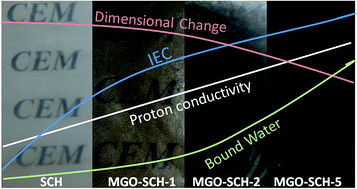Synthesis of highly stable and high water retentive functionalized biopolymer-graphene oxide modified cation exchange membranes†
Abstract
Usage of polymer electrolyte membranes in energy based devices is substituting the conventional electrolytes. Herein, we have synthesized a PEM based biopolymer functionalized with silica modified GO and PVA. GO has been modified in two steps to synthesize silica grafted sulfonated GO. The functionalization of chitosan has been performed using 1,3-propane sultone after deacetylation. Furthermore, PVA has been used as a polymer matrix because PVA possesses good film forming property with mechanical stability. Different weight% (1, 2 and 5) of modified GO has been incorporated into the chitosan matrix. The prepared PEMs have been subjected to different types of characterization such as structural, thermal, mechanical and electrochemical characterization. The nano-hybrid membranes show significant increment in electrochemical properties. MGO–SCH-5 membrane shows a proton conductivity of 6.77 × 10−2 S cm−1, which increases to 11.2 × 10−2 S cm−1 at 90 °C. The thermal and mechanical stability of PEM also increases with MGO content in the sulfonated chitosan. The elastic modulus for the MGO–SCH-5 membrane is calculated to be 21.37 MPa with 54 MPa of maximum stress. Thus, these membranes may be targeted as PEMs for higher temperature energy applications.


 Please wait while we load your content...
Please wait while we load your content...